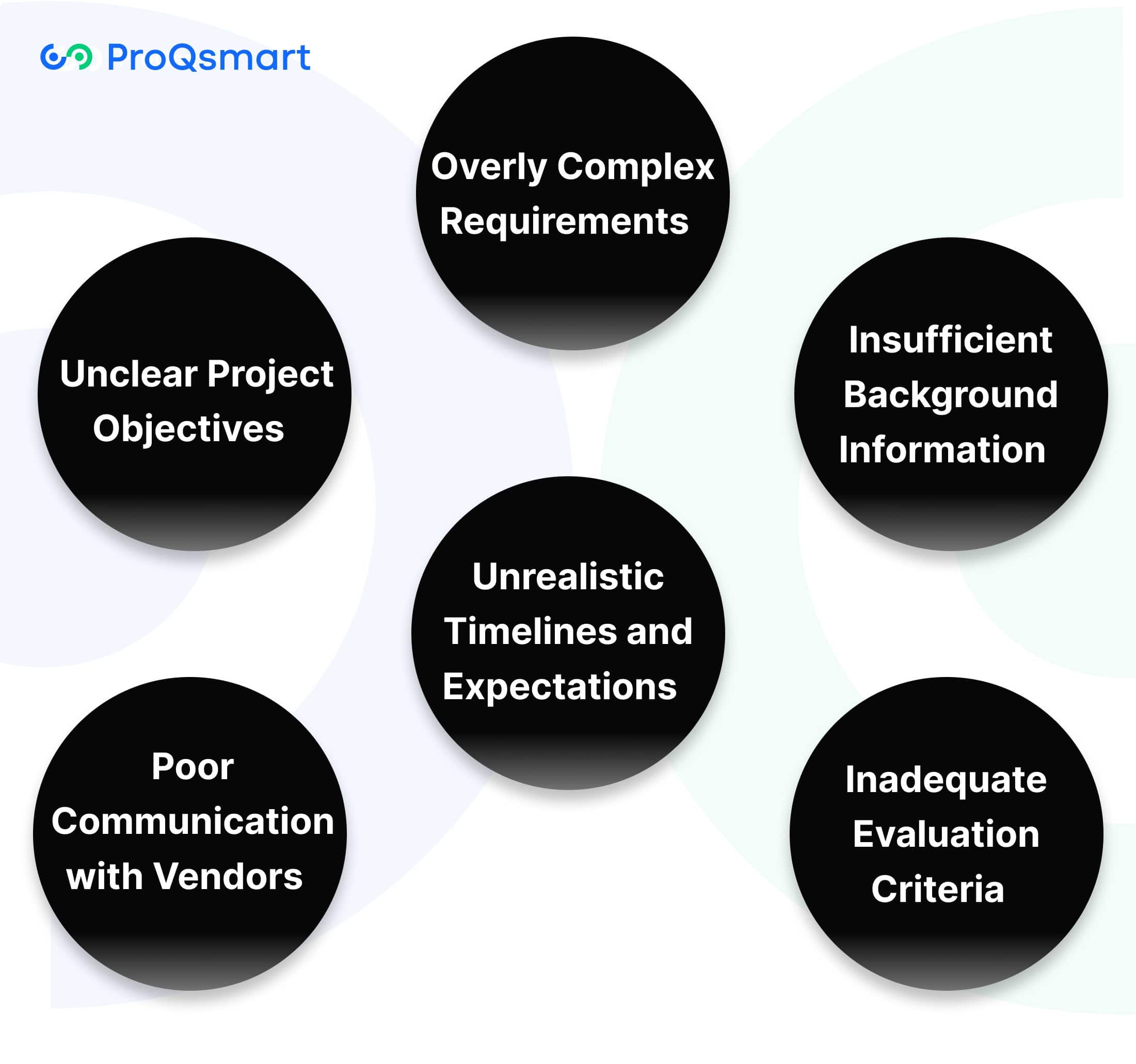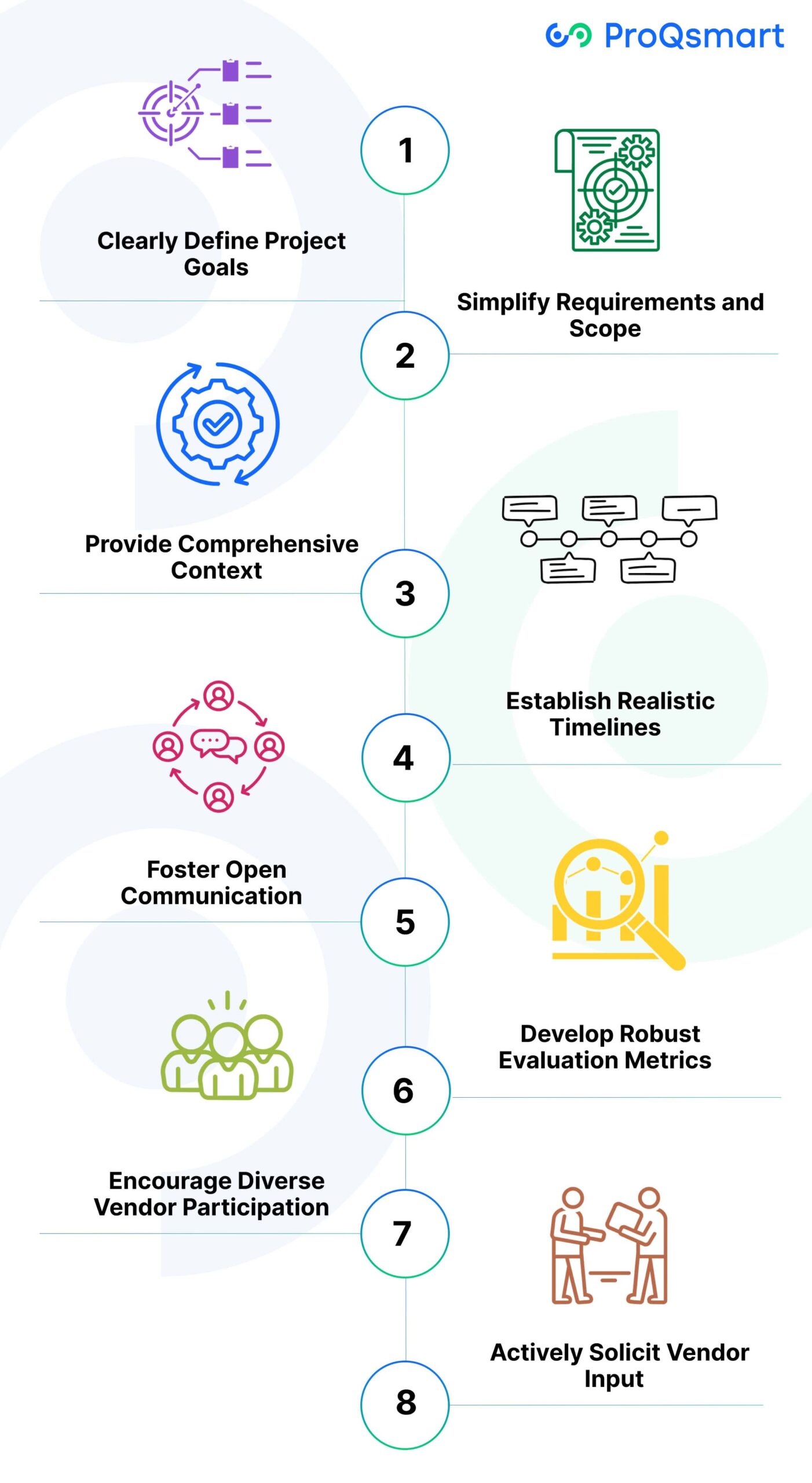A well-crafted Request for Proposal (RFP) is a critical tool in procurement, designed to identify the best-fit vendors for a project. However, even experienced procurement teams often struggle with RFPs that fail to attract the right suppliers—leading to mismatched proposals, limited competition, or vendors that don’t fully align with project needs.
While RFPs are meant to ensure transparency, consistency, and strategic decision-making, their effectiveness depends on how well they are structured and communicated. Factors like unclear requirements, overly rigid evaluation criteria, or poor market engagement can drive away qualified vendors, leaving businesses with subpar options.
This article explores common pitfalls in RFP design and execution, along with actionable strategies to refine your approach. From improving clarity and supplier engagement to leveraging digital tools, you’ll discover how to craft RFPs that attract the right vendors and drive better procurement outcomes.
Why Do RFPs Fail?
- Major reason RFPs fail is a lack of alignment in what the project is trying to achieve. When the RFP is centered around features rather than desired outcomes, it’s confusing and misleading for vendors. Requesting a list of required functionalities upfront is key. Without telling them how they align with your goals, vendors can’t customize their proposals to hit the mark.
- Vendors frequently undercut themselves in these scenarios because they treat it as a shot in the dark. At the same time, murky expectations keep them from participating in a serious way. Poorly defined requirements scuttle the effort too. If your scope, budget, or evaluation criteria is ambiguous, you’ll get wildly different responses from vendors.
- Vendors are reluctant to invest too much if budget parameters aren’t clear, and this misalignment can often sink a selection process.
- Poor communication only exacerbates these problems. With insufficient communication throughout the process, diverse suppliers can be excluded.
- Lastly, unrealistic timelines are an all too common trap. Considering RFPs can sometimes take upwards of a few months or even a year, unreasonable, rushed deadlines will hurt quality and vendor participation.
"Don't let the complexities of RFP drafting slow you down. Download our ready-to-use RFP template and take the first step towards efficient vendor selection and project success"
Common Pitfalls in the RFP Process

Request for Proposals (RFPs) are crucial tools in public procurement, yet they often miss the mark due to common pitfalls. By avoiding these issues, the RFP process can transform into a more strategic and productive exercise for potential bidders and agencies alike.
1. Unclear Project Objectives
When project goals are unclear, vendors cannot tailor their proposals to suit your needs. This misalignment only leads to wasted resources and proposals that do not meet the needs required. To prevent this, assertively define and communicate your goals, making sure they reflect the broad priorities of your organization.
If the intent is to reduce costs with new technology, clearly define the deliverables, expectations and metrics for success. Clear and concise direction leads to better and more focused proposals.
2. Overly Complex Requirements
Unnecessarily detailed or complex requirements deter bidders and extend the timeline. Less is more. Simpler RFPs yield better responses from interested vendors and promote competitive, high-quality submissions.
Provide enough detail to convey clear expectations while avoiding unnecessary complexity by zeroing in on what’s really needed. For example, rather than requiring detailed technical specifications, focus on the essential functions that help you achieve your objectives.
Tools such as ProQsmart make this process much easier by automating the requirement workflows and matching requirements to budgetary constraints.
3. Insufficient Background Information
Failure to provide complete project context limits a vendor’s opportunity to offer customized solutions. Provide detailed organizational history, project precedents, and other relevant data.
For instance, letting potential vendors know about past procurement issues can help vendors create a solution that solves the right problems. Being transparent will not only help engender trust, it will ensure quality proposals.
4. Unrealistic Timelines and Expectations
Most importantly, rushed timelines really do sacrifice quality and smart vendor engagement. Avoid the pitfall by giving vendors enough time to process what they need to do and respond to you appropriately.
If the project requires raising capital expenditure, allow vendors sufficient time. This will allow them to better schedule and develop well thought-out proposals. Project flexibility is key to improving collaboration and reducing costly project delays.
5. Poor Communication with Vendors
Breakdowns in communication result in unnecessary ambiguity and erode potential vendor relationships. Maintain consistent and open dialogue, responding to questions in a timely fashion.
ProQsmart shines here by enabling more real-time collaboration, building stronger relationships with suppliers, and improving the transparency of the entire process.
6. Inadequate Evaluation Criteria
Vague metrics create the opportunity for subjective decisions to be made, eroding the public’s trust. Set objective, quantifiable, and relevant criteria that relate to project objectives.
If cost savings in particular are a goal, identify concrete benchmarks for those. Fair evaluations allow for a fair competition and foster a more productive relationship with your vendors.
How to Revitalize Your RFP Strategy

It’s time to reevaluate your RFP strategy if you want to reap the benefits of public procurement. By incorporating a structured framework that includes defined steps and technology, you can enhance client relationships and transform your RFP processes into a powerful, efficient tool for potential bidders.
1. Clearly Define Project Goals
Well-articulated project objectives are the bedrock of a smart RFP strategy. By articulating your measurable objectives, you’ll drive vendors to formulate more tailored proposals that best match your needs. If your true target is 15% cost savings without sacrificing quality, then be explicit with that intent.
In doing so, proposals will speak directly to your goals. Engaging with key stakeholders is essential to ensure that these goals are harmonized with larger goals of the organization. Their insights can frequently illuminate priorities that refine the scope of your RFP, helping you ensure relevance and precision.
2. Simplify Requirements and Scope
Having unnecessarily complicated or rigid requirements is another way to scare off your ideal vendors. Breaking down the project scope into specific, tangible tasks will help ensure your RFP is easy to understand. Dividing up a construction project into phases allows for more targeted solutions that are easier for vendors to respond to.
These phases may involve design, permitting, and execution. When you’re clear, you avoid wasting everyone’s time with misunderstandings, allowing you to get clearer, higher-quality responses.
3. Provide Comprehensive Context
Giving comprehensive context gives vendors the tools they need to understand what you’re expecting, and the challenges you’re tackling. Adding in market trends, organizational goals, and constraints increases their capacity to propose relevant solutions.
For instance, if you provide a market analysis showing that materials costs are rising, you might encourage vendors to suggest creative ways to save costs. Creating a climate of transparency and trust by sharing your internal challenges will allow you to attract more creative responses.
4. Establish Realistic Timelines
When deadlines are unrealistic, quality of proposal suffers. Developing a project workback schedule will make sure each RFP phase has enough time allotted for development and review. For instance, giving 4 weeks for proposal submissions gives vendors the ability to craft intentional responses.
Giving a bit of flex in timelines helps account for unexpected delays, enhancing vendor participation and satisfaction.
5. Foster Open Communication
Open and transparent communication fosters trust and stakeholder engagement. Inviting vendors to ask questions about RFP specifics helps set everyone on the same page. For example, including a pre-submission Q&A session gives vendors an opportunity to clarify ambiguities.
Consistently prompt responses to all inquiries exhibit a high level of professionalism and bolster relationships with existing vendors and prospects.
6. Develop Robust Evaluation Metrics
The right evaluation metrics are key to choosing the best vendor. Criteria like cost, quality, and innovation need to match your project objectives. For instance, if you use a weighted scoring system you can give more weight to the factors that are most important to you.
By involving stakeholders in defining these metrics, you can help ensure that decision-making is more equitable and more holistic.
7. Encourage Diverse Vendor Participation
We know that diversity in vendor participation drives innovation. Engaging with underrepresented vendors via targeted outreach initiatives expands your pool of possibilities and potential vendors to choose from. For example, working with small businesses or minority-owned firms can result in innovative solutions.
An inclusive and welcoming RFP process helps make sure that as many qualified bidders as possible apply.
8. Actively Solicit Vendor Input
Soliciting vendor feedback and implementing their suggestions into your RFP will only improve the process. For instance, asking for input on how to better use templates or workflows can reveal time-wasting practices.
Creating collaborative relationships encourages a spirit of partnership that results in more competitive proposals and extended engagement.
ProQsmart makes it easy to streamline these processes, leveraging AI to drive efficiencies and automate compliance and collaboration in real-time. It builds trust with suppliers, puts procurement back in line with budgets, and adds transparency even to vendor scoring.
Streamline the RFP Process
Streamlining the Request for Proposal (RFP) process is key to improving efficiency in public procurement. It increases vendor competition and results in stronger procurement outcomes. By implementing modern bidding practices and technology, you can streamline every step while ensuring you get the most value for your agency.
1. Assemble a Skilled RFP Team
Having an experienced RFP team helps you maintain control through the process. Have dedicated project managers responsible for the delivery schedule. Engage subject matter experts to help craft requirements and procurement professionals to help evaluate proposals.
By choosing members with varying areas of expertise, you facilitate more holistic decision making. With regular training sessions to prepare the team, they’re able to stay up to date on market trends and RFP best practices, becoming more effective over time.
2. Prepare Before Drafting the RFP
Doing proper RFP preparation work is the key to developing a great RFP. Complete this process by researching industry trends and vendor capabilities to best align with market realities. Engage stakeholders early and often to identify and meet their needs and expectations.
Define your goals and needs from the start to craft an intentional and purposeful document.
3. Write a Clear and Concise RFP Document
A well-written RFP document encourages and promotes vendor comprehension. Write for a smart but non-expert general audience. Skip the jargon and use bullet points to draw attention to the most important details.
For example, providing useful templates, such as those found in ProQsmart, makes things easier and removes duplicative work.
4. Distribute the RFP Effectively
Not to mention, effective distribution increases your potential bidders pool. Utilize platforms like ProQsmart and targeted outreach to enhance visibility. Share submission deadlines and requirements upfront to safeguard against delays in the bidding process.
5. Manage the Question Period
Structured Q&A periods help clear up vendor confusion during the bidding process. Being open and quick with responses to inquiries fosters a strong client relationship and accountability. ProQsmart’s collaboration tools ensure potential bidders stay informed, receiving the same answer every time.
6. Select the Best-Fit Partner
Emphasize capabilities, experience, and cultural fit over cost in your RFP process. With ProQsmart, procurement professionals enhance decision-making during the public procurement process with real-time supplier performance, cost, and more.
Essential Components of a Winning RFP
A clearly written and thought out Request for Proposal (RFP) sets the stage for a strong and beneficial procurement. It creates an environment of trust and cooperation between the client and vendor. By honing in on these essential components, you can create a winning RFP that brings in the most qualified vendors and sets your project up for success.
Below, I dive into some of the essential components to keep in mind.
1. Craft a Compelling Client Introduction
The introduction is where you set the tone of your RFP. I stress the importance of building that credibility, which should start with the organization’s mission statement, core values, and history of success within procurement.
For instance, you might want to emphasize your dedication to sustainability or focus on promoting successful projects. This approach does not just engage potential vendors, it builds trust. A concise, well-presented introduction will show you mean business and prompt vendors to focus their effort on submitting proposals fit to your needs.
2. Provide Detailed Project Information
Providing detailed project descriptions will help guide vendors in crafting their proposals to best meet your needs. I suggest you include your project scope, objectives, budget range, and project history.
For example, when procuring materials for a capital project, get specific on the quality requirements, the required quantities, and the delivery schedule. Better clarity on your end reduces confusion and ensures better proposals.
3. Include Clear Contact Information
Easy-to-find contact information makes it easy to get in touch. Clarify the process to ask questions, designating specific points of contact.
Make sure email addresses and phone numbers are up to date. Responsiveness goes a long way. Quick answers to vendor questions show your organization means business and creates goodwill.
4. Define the Project Statement of Work
Outlining specific deliverables, timelines, and roles/responsibilities helps to ensure everyone is on the same page with expectations. For instance, establish milestones for phased deliverables to hold them accountable.
A clear, concise problem statement focuses the vendors’ responses around your needs, keeping them aimed at your project goals.
5. Outline the RFP’s Purpose
If you don’t clearly articulate the goals of the RFP, vendors won’t know what you’re trying to accomplish. Make it clear what you want – for example, if you want to reduce costs or drive innovation.
Clarifying the purpose and aligning it with your organizational priorities helps attract vendors who care about your vision.
6. Describe the Project in Detail
Detailed and thorough descriptions help vendors give you their best possible responses. Define measurable requirements, standards, and address challenges upfront.
For example, call attention to regulatory compliance requirements or unique site-specific circumstances. This level of transparency not only strengthens proposals but helps to prevent costly delays.
7. Specify Key Milestones and Deadlines
Clear and definite deadlines allow for the timely submission of materials and efficient progression of the project. It is recommend timelines that are realistic, with some wiggle room for delays that may occur.
For instance, allow for multiple evaluation phases so they allow for careful review without needing to rush decisions.
8. Detail Proposal Submission Procedures
Concise directions regarding submission format, deadlines, and evaluation criteria further help to simplify the process. Look to procurement technology such as ProQsmart, an AI-powered procurement compliance platform, to help automate procurement workflows and maintain compliance.
Improvements such as e-tenders and supplier performance monitoring make the RFP process more efficient.
Enhance Vendor Engagement and Response

Enhancing vendor engagement and response quality is essential to realizing better RFP results in the public procurement process. Through intentional communication practices and well-defined response processes, organizations can tap into the true power of vendor partnerships, leading to much better aligned proposals that address client requirements and business goals.
Offer Opportunities for Clarification
Offering at least one opportunity for vendors to ask questions will help clear up misinterpretation and prevent confusion from occurring. Structured Q&A sessions or online forums create a space for honest dialogue and give vendors an opportunity to clarify any confusion.
For example, designating a specific time for Q&A and posting answers publicly helps ensure all bidders receive the same information and fosters transparency. Good communication of these sessions, like with clear timelines in the RFP/RFI document, helps make sure that vendors know what to expect and come prepared.
Responding to questions in a timely manner increases the likelihood of receiving a high-quality proposal. Perhaps most importantly, it demonstrates a spirit of collaboration, which improves the quality of vendor submissions.
ProQsmart makes this a whole lot easier by providing highly efficient tools to help you keep communication flowing and transparency alive for all vendors in the RFP lifecycle.
Provide Constructive Feedback
Providing constructive feedback post-evaluation builds better rapport with the vendor community. Specific and actionable insights, such as detailing areas of improvement in pricing structures or technical solutions, guide vendors in refining future proposals.
Providing feedback lays the groundwork for future collaboration, building trust and a cycle of ongoing improvement into the procurement process.
Build Long-Term Relationships
Ensuring those relationships continue beyond the RFP process is key to long-term success. Whether it’s through quarterly performance reviews, joint planning sessions, or other mechanisms, keeping the lines of communication open is key to staying aligned and building trust.
Technology such as ProQsmart helps companies automate the process of monitoring supplier performance creating a more productive, transparent, and respectful partnership. Long-term partnership, based on trust and respect, produces highly successful project results, efficient workflows, and growth for all.
Transparency and reliability are the foundation of these relationships, helping to ensure that vendor engagement is aligned with organizational goals and values.
Conclusion
RFPs can be a powerful tool when properly executed. Having clear goals, smart planning, and open lines of communication with vendors goes a long way. Minor adjustments, such as rewording your questions or making your process more user-friendly, can help you get more productive responses and build more fruitful collaborations. Remaining organized and clear keeps you from receiving proposals that don’t fit your needs, and saves everyone time in the process.
With the right approach to RFPs, you can identify trustworthy vendors, increase efficiency, and save money. It’s not about producing a shiny new toy, it’s about delivering value to your staff and establishing a foundation for success in the future.
Don’t wait until the next RFP to take action—start optimizing your process today. Book a demo with ProQsmart and see how smarter RFP management can drive better procurement outcomes.






